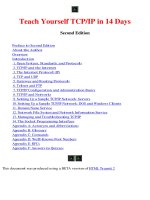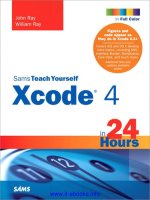sams teach yourself tcp ip in 24 hours phần 1 potx
Bạn đang xem bản rút gọn của tài liệu. Xem và tải ngay bản đầy đủ của tài liệu tại đây (7.8 MB, 46 trang )
ptg
From the Library of Athicom Parinayakosol
ptg
What you should already have to get the most out of this book…
• Familiarity with computer basics
• Basic knowledge of computer operating systems
Some books
that may
help…
Sams Teach Yourself
Microsoft Windows
Vista All in One
ISBN 0-672-32889-5
A quick, easy introduction
to Windows
Sams Teach Yourself
PHP, MySQL, and Apache
All in One
ISBN 0-672-32976-X
A step-by-step approach to
basic setup and creation of
interactive web applications
Possible
titles to
look for…
Sams Teach Yourself
Unix System
Administration in
24 Hours
ISBN 0-672-32398-2
An introduction to managing
a Unix system
Where to go from here…
• Learn to automate system administration tasks with scripting
• Expand your system administration skills in Unix
Related
titles…
Sams Teach Yourself
Networking in
24 Hours
ISBN 0-672-32608-6
A solid introduction to
networking technology
Sams Teach Yourself
Shell Programming in
24 Hours
ISBN 0-672-32358-3
An easy-to-understand
guide to Unix scripting
Sams Teach Yourself
Network Troubleshooting
in 24 Hours
ISBN 0-672-32373-7
A beginner’s guide to
finding and fixing network
problems
What this book will help you learn…
• How to set up and administer a TCP/IP network
• How to troubleshoot network problems
Sams TeachYourself
TCP
/
IP
24
in
Hours
From the Library of Athicom Parinayakosol
ptg
800 East 96th Street, Indianapolis, Indiana, 46240 USA
Joe Casad
Sams TeachYourself
24
in
Hours
TCP/IP
From the Library of Athicom Parinayakosol
ptg
Sams Teach Yourself TCP/IP in 24 Hours
Copyright © 2009 by Pearson Education, Inc.
All rights reserved. No part of this book shall be reproduced, stored in a retrieval system, or
transmitted by any means, electronic, mechanical, photocopying, recording, or otherwise, without
written permission from the publisher. No patent liability is assumed with respect to the use of
the information contained herein. Although every precaution has been taken in the preparation of
this book, the publisher and author assume no responsibility for errors or omissions. Nor is any
liability assumed for damages resulting from the use of the information contained herein.
ISBN-13: 978-0-672-32996-8
ISBN-10: 0-672-32996-4
Library of Congress Cataloging-in-Publication Data:
Casad, Joe, 1958-
Sams teach yourself TCP/IP in 24 hours / Joe Casad. — 4th ed.
p. cm.
Includes index.
ISBN-13: 978-0-672-32996-8 (pbk.)
ISBN-10: 0-672-32996-4 (pbk.)
1. TCP/IP (Computer network protocol) I. Title. II. Title: Teach yourself TCP/IP in 24 hours.
III. Title: TCP/IP in 24 hours.
TK5105.585.C37 2009
005.7’1376—dc22
2008031826
Printed in the United States of America
First Printing September 2008
Trademarks
All terms mentioned in this book that are known to be trademarks or service marks have been
appropriately capitalized. Sams Publishing cannot attest to the accuracy of this information. Use
of a term in this book should not be regarded as affecting the validity of any trademark or service
mark.
Warning and Disclaimer
Every effort has been made to make this book as complete and as accurate as possible, but no
warranty or fitness is implied. The information provided is on an “as is” basis. The author and the
publisher shall have neither liability nor responsibility to any person or entity with respect to any
loss or damages arising from the information contained in this book.
Bulk Sales
Sams Publishing offers excellent discounts on this book when ordered in quantity for bulk pur-
chases or special sales. For more information, please contact
U.S. Corporate and Government Sales
1-800-382-3419
For sales outside of the U.S., please contact
International Sales
Editor-in-Chief
Mark Taub
Acquisitions Editor
Trina MacDonald
Development
Editor
Michael Thurston
Managing Editor
Kristy Hart
Project Editor
Betsy Harris
Indexer
Lisa Stumpf
Proofreader
San Dee Phillips
Technical Editor
Ravi Prakash
Publishing
Coordinator
Olivia Basegio
Book Designer
Gary Adair
Compositor
Nonie Ratcliff
From the Library of Athicom Parinayakosol
ptg
Contents at a Glance
Part I: TCP/IP Basics
HOUR 1 What Is TCP/IP? 7
2 How TCP/IP Works
21
Part II: The TCP/IP Protocol System
HOUR 3 The Network Access Layer 35
4 The Internet Layer
47
5 Subnetting and CIDR
69
6 The Transport Layer
83
7 The Application Layer
107
Part III: Networking with TCP/IP
HOUR 8 Routing 121
9 Getting Connected
143
10 Firewalls
175
11 Name Resolution
185
12 Automatic Configuration
215
13 IPv6—The Next Generation
229
Part IV: TCP/IP Utilities
HOUR 14 TCP/IP Utilities 243
15 Monitoring and Remote Access
275
Part V: TCP/IP and the Internet
HOUR 16 The Internet: A Closer Look 297
17 HTTP, HTML, and the World Wide Web
305
18 Email
321
19 Streaming and Casting
339
From the Library of Athicom Parinayakosol
ptg
Part VI: Advanced Topics
HOUR 20 Web Services 353
21 The New Web
363
22 Network Intrusion
375
23 TCP/IP Security
391
24 Implementing a TCP/IP Network—Seven Days
in the Life of a Sys Admin
413
Index 425
iv
Sams Teach Yourself TPC/IP in 24 Hours
From the Library of Athicom Parinayakosol
ptg
Table of Contents
Introduction 1
Part I: TCP/IP Basics
HOUR 1: What Is TCP/IP? 7
Networks and Protocols 8
The Development of TCP/IP
10
TCP/IP Features
12
Standards Organizations and RFCs
17
Summary
18
Q&A
19
Key Terms
19
HOUR 2:
How TCP/IP Works 21
The TCP/IP Protocol System 22
TCP/IP and the OSI Model
24
Data Packages
26
A Quick Look at TCP/IP Networking
28
Summary
30
Q&A
30
Key Terms
31
Part II: The TCP/IP Protocol System
HOUR 3: The Network Access Layer 35
Protocols and Hardware 35
The Network Access Layer and the OSI Model
37
Network Architecture
38
Physical Addressing
40
From the Library of Athicom Parinayakosol
ptg
Ethernet 41
Anatomy of an Ethernet Frame
43
Summary
44
Q&A
44
Key Terms
45
HOUR 4:
The Internet Layer 47
Addressing and Delivering 48
Internet Protocol (IP)
50
Address Resolution Protocol (ARP)
62
Reverse ARP (RARP)
63
Internet Control Message Protocol (ICMP)
63
Other Internet Layer Protocols
64
Summary
65
Q&A
65
Workshop
66
Key Terms
66
HOUR 5:
Subnetting and CIDR 69
Subnets 69
Dividing the Network
70
Converting a Subnet Mask to Dotted Decimal Notation
73
Working with Subnets
75
Classless Internet Domain Routing (CIDR)
80
Summary
81
Q&A
81
Key Terms
82
HOUR 6:
The Transport Layer 83
Introducing the Transport Layer 84
Transport Layer Concepts
85
Understanding TCP and UDP
91
Firewalls and Ports
101
vi
Sams Teach Yourself TPC/IP in 24 Hours
From the Library of Athicom Parinayakosol
ptg
Summary 102
Q&A
103
Key Terms
104
HOUR 7:
The Application Layer 107
What Is the Application Layer? 107
The TCP/IP Application Layer and OSI
108
Network Services
109
APIs and the Application Layer
114
TCP/IP Utilities
115
Summary
116
Q&A
116
Key Terms
117
Part III: Networking with TCP/IP
HOUR 8: Routing 121
Routing in TCP/IP 121
Routing on Complex Networks
134
Examining Interior Routers
136
Classless Routing
138
Higher in the Stack
139
Summary
140
Q&A
140
Key Terms
141
HOUR 9:
Getting Connected 143
Dial-Up Networking 144
Cable Broadband
151
Digital Subscriber Line (DSL)
153
Wide Area Networks (WANs)
154
Wireless Networking
155
Connectivity Devices
167
Contents
vii
From the Library of Athicom Parinayakosol
ptg
Summary 171
Q&A
171
Key Terms
172
HOUR 10:
Firewalls 175
What Is a Firewall? 175
Firewall Options
177
The DMZ
178
Firewall Rules
180
Proxy Service
181
Reverse Proxy
182
Summary
183
Q&A
183
Key Terms
184
HOUR 11:
Name Resolution 185
What Is Name Resolution? 185
Name Resolution Using Hosts Files
187
DNS Name Resolution
189
Registering a Domain
195
Managing DNS
196
Dynamic DNS
203
NetBIOS Name Resolution
204
Summary
211
Q&A
211
Workshop
212
Key Terms
212
HOUR 12:
Automatic Configuration 215
The Case for Server-Supplied IP Addresses 215
What Is DHCP?
216
How DHCP Works
217
Configuring DHCP
220
DHCP Server Configuration
221
viii
Sams Teach Yourself TPC/IP in 24 Hours
From the Library of Athicom Parinayakosol
ptg
Network Address Translation (NAT) 223
Zero Configuration
224
Summary
227
Q&A
227
Key Terms
228
HOUR 13:
IPv6—The Next Generation 229
Why a New IP? 229
IPv6 Header Format
232
IPv6 Addressing
236
IPv6 with IPv4
237
IPv6 and Quality of Service (QoS)
238
Summary
239
Q&A
239
Key Terms
240
Part IV: TCP/IP Utilities
HOUR 14: TCP/IP Utilities 243
Connectivity Problems 244
Protocol Dysfunction and Misconfiguration
245
Line Problems
252
Name Resolution Problems
253
Network Performance Problems
254
Using Connectivity Utilities to Troubleshoot Problems
261
File Transfer Protocol (FTP)
262
Trivial File Transfer Protocol (TFTP)
267
Remote Copy
267
Integrating Network File Access
268
Summary
270
Q&A
270
Workshop
271
Key Terms
272
Contents
ix
From the Library of Athicom Parinayakosol
ptg
HOUR 15: Monitoring and Remote Access 275
Telnet 275
Berkeley Remote Utilities
278
Secure Shell (SSH)
282
Screen Sharing
283
Simple Network Management Protocol
284
Remote Monitoring
289
Summary
291
Q&A
291
Key Terms
292
Part V: TCP/IP and the Internet
HOUR 16: The Internet: A Closer Look 297
How the Internet Looks 297
What Happens on the Internet
299
URIs and URLs
301
Summary
304
Q&A
304
Key Terms
304
HOUR 17:
HTTP, HTML, and the World Wide Web 305
What Is the World Wide Web? 305
Understanding HTML
308
Understanding HTTP
313
Dynamic HTML
316
Summary
318
Q&A
318
Key Terms
319
HOUR 18:
Email 321
What Is Email? 321
Email Format
322
How Email Works
324
x
Sams Teach Yourself TPC/IP in 24 Hours
From the Library of Athicom Parinayakosol
ptg
Simple Mail Transfer Protocol (SMTP) 326
Retrieving the Mail
328
Email Readers
331
Webmail
333
Spam
334
Summary
336
Q&A
337
Workshop
337
Key Terms
338
HOUR 19:
Streaming and Casting 339
The Streaming Problem 339
Realtime Transport Protocol (RTP)
341
Transport Options
343
Multimedia Links
344
Podcasting
346
Voice Over IP (VoIP)
347
Summary
348
Q&A
349
Key Terms
349
Part VI: Advanced Topics
HOUR 20: Web Services 353
Understanding Web Services 353
XML
355
SOAP
357
WSDL
358
Web Service Stacks
358
E-Commerce
359
Summary
361
Q&A
362
Key Terms
362
Contents
xi
From the Library of Athicom Parinayakosol
ptg
HOUR 21: The New Web 363
Web 2.0 363
XHTML
367
Peer-to-Peer
368
IRC and Instant Messaging
369
The Semantic Web
371
Summary
372
Q&A
373
Key Terms
373
HOUR 22:
Network Intrusion 375
Vandals and Cyber-Crooks 375
What Do Intruders Want?
376
Root Access
385
Going Phishing
386
Denial-of-Service Attacks
387
Summary
389
Key Terms
389
HOUR 23:
TCP/IP Security 391
Encryption 391
Securing TCP/IP
402
Virtual Private Networks (VPNs)
404
Kerberos
406
Summary
409
Q&A
409
Key Terms
410
HOUR 24:
Implementing a TCP/IP Network—Seven Days in the Life
of a Sys Admin 413
A Brief History of Hypothetical, Inc. 413
Seven Days in the Life of Maurice
414
Summary
422
Q&A
423
xii
Sams Teach Yourself TPC/IP in 24 Hours
From the Library of Athicom Parinayakosol
ptg
About the Author
Joe Casad is an engineer, author, and editor who has written widely on computer network-
ing and system administration. He has written or co-written 12 books on computers and
networking. In a past life, he was the editor of C/C++ Users Journal and senior editor of
UnixReview.com.
From the Library of Athicom Parinayakosol
ptg
Dedication
To the sound of three hands clapping.
—Joe Casad
Acknowledgments
Thanks to Trina MacDonald, Michael Thurston, Betsy Harris, and Ravi Prakash for their
patience and good advice. I would also like to acknowledge the following individuals for
their contributions to previous editions of Sams Teach Yourself TCP/IP in 24 Hours: Bob
Willsey, Sudha Putnam, Walter Glenn, Art Hammond, Jane Brownlow, Jeff Koch, Mark
Renfrow, Vicki Harding, Mark Cierzniak, Marc Charney, and Jenny Watson.
From the Library of Athicom Parinayakosol
ptg
We Want to Hear from You!
As the reader of this book, you are our most important critic and commentator. We value
your opinion and want to know what we’re doing right, what we could do better, what
areas you’d like to see us publish in, and any other words of wisdom you’re willing to pass
our way.
You can email or write me directly to let me know what you did or didn’t like about this
book—as well as what we can do to make our books stronger.
Please note that I cannot help you with technical problems related to the topic of this book, and
that due to the high volume of mail I receive, I might not be able to reply to every message.
When you write, please be sure to include this book’s title and author as well as your name
and phone or email address. I will carefully review your comments and share them with the
author and editors who worked on the book.
E-mail:
Mail: Mark Taub
Editor-in-Chief
Sams Publishing
1330 Avenue of the Americas
New York, NY 10019 USA
Reader Services
Visit our website and register this book at informit.com/register for convenient access to any
updates, downloads, or errata that might be available for this book.
From the Library of Athicom Parinayakosol
ptg
This page intentionally left blank
From the Library of Athicom Parinayakosol
ptg
Introduction
Welcome to Sams Teach Yourself TCP/IP in 24 Hours, Fourth Edition. This book provides a clear
and concise introduction to TCP/IP for newcomers, and also for users who have worked with
TCP/IP but would like a little more of the inside story. The fourth edition includes new
material on recent developments in TCP/IP and offers a closer look at topics such as
.
Firewalls
.
Streaming
.
Web services
You’ll find new chapters on casting and streaming, web services, and the new Web, as well
as several new sections throughout the book on recent developments in TCP/IP.
Does Each Chapter Take an Hour?
Each chapter is organized so that you can learn the concepts within one hour. The chapters
are designed to be short enough to read all at once. In fact, you should be able to read a
chapter in less than one hour and still have time to take notes and reread more complex
sections in your one-hour study session.
How to Use This Book
The books in the Sams Teach Yourself series are designed to help you learn a topic in a few
easy and accessible sessions. Sams Teach Yourself TCP/IP in 24 Hours, Fourth Edition, is divided
into six parts. Each part brings you a step closer to mastering the goal of proficiency in
TCP/IP.
.
Part I, “TCP/IP Basics,” introduces you to TCP/IP and the TCP/IP protocol stack.
.
Part II, “The TCP/IP Protocol System,” takes a close look at each of TCP/IP’s protocol
layers: the Network Access, Internet, Transport, and Application layers. You learn
about IP addressing and subnetting, as well as physical networks and application
services. You’ll also learn about the protocols that operate at each of TCP/IP’s layers.
From the Library of Athicom Parinayakosol
ptg
.
Part III, “Networking with TCP/IP,” describes some of the devices, services, and utilities
necessary for supporting TCP/IP networks. You learn about routing and network hard-
ware, DHCP, DNS, and IPv6.
.
Part IV, “TCP/IP Utilities,” introduces some of the common utilities used to configure,
manage, and troubleshoot TCP/IP networks. You learn about Ping, Netstat, FTP,
Telnet, and other network utilities.
.
Part V, “TCP/IP and the Internet,” describes the world’s largest TCP/IP network: the
Internet. You learn about the structure of the Internet. You also learn about HTTP,
HTML, XML, email, and Internet streaming.
.
Part VI, “Advanced Topics,” describes topics such as web services, messaging, the
semantic web, and TCP/IP security. Part VI ends with a case study showing how the
components of TCP/IP interact in a real working environment.
The concepts in this book, like TCP/IP itself, are independent of a system and descend from
the standards defined in Internet Requests for Comment (RFCs).
How This Book Is Organized
Each hour in Sams Teach Yourself TCP/IP in 24 Hours, Fourth Edition, begins with a quick intro-
duction and a list of goals for the hour. You can also find the following elements.
Main Section
Each hour contains a main section that provides a clear and accessible discussion of the
hour’s topic. You’ll find figures and tables helping to explain the concepts described in the
text. Interspersed with the text are special notes labeled By The Way? These notes come
with definitions, descriptions, or warnings that help you build a better understanding of the
material.
These boxes clarify a concept that is discussed in the text. A By The Way might
add some additional information or provide an example, but they typically aren’t
essential for a basic understanding of the subject. If you’re in a hurry, or if you
want to know only the bare essentials, you can bypass these sidebars.
2
Sams Teach Yourself TCP/IP in 24 Hours
By the
Way
From the Library of Athicom Parinayakosol
ptg
Q&A
Each hour ends with some questions designed to help you explore and test your under-
standing of the concepts described in the hour. Complete answers to the questions are also
provided.
Additionally, some hours include Workshops—exercises designed to help you
through the details or give you practice with a particular task. You’ll find them only
in hours where a little real-world exploration will help build a better understanding
of the material. Even if you don’t have the necessary software and hardware to
undertake some of the exercises in the Workshop, you might benefit from reading
through the exercises to see how the tools work in a real network implementation.
Key Terms
Each hour includes a summary of important key terms that are introduced in the hour. The
key terms are compiled into an alphabetized list at the end of each hour.
Introduction
3
By the
Way
From the Library of Athicom Parinayakosol
ptg
This page intentionally left blank
From the Library of Athicom Parinayakosol
ptg
PART I
TCP/IP Basics
HOUR 1 What Is TCP/IP? 7
HOUR 2
How TCP/IP Works 21
From the Library of Athicom Parinayakosol
ptg
This page intentionally left blank
From the Library of Athicom Parinayakosol
ptg
HOUR 1
What Is TCP/IP?
What You’ll Learn in This Hour:
.
Networks and network protocols
.
History of TCP/IP
.
Important features of TCP/IP
TCP/IP is a protocol system—a collection of protocols that supports network communica-
tions. The answer to the question What is a protocol? must begin with the question What is
a network?
This hour describes what a network is and shows why networks need protocols. You’ll also
learn what TCP/IP is, what it does, and where it began.
At the completion of this hour, you’ll be able to
.
Define the term network
.
Explain what a network protocol suite is
.
Explain what TCP/IP is
.
Discuss the history of TCP/IP
.
List some important features of TCP/IP
.
Identify the organizations that oversee TCP/IP and the Internet
.
Explain what RFCs are and where to find them
From the Library of Athicom Parinayakosol









